

Clayton Christensen. The Innovator's Dilemma In his book, The Innovator's Dilemma [3], Professor Clayton Christensen of Harvard Business School describes a theory about how large, outstanding firms can fail "by doing everything right.

" The Innovator's Dilemma, according to Christensen, describes companies whose successes and capabilities can actually become obstacles in the face of changing markets and technologies. Christensen describes two types of technologies: sustaining technologies and disruptive technologies. Sustaining technologies are technologies that improve product performance. These are technologies that most large companies are familiar with; technologies that involve improving a product that has an established role in the market.
Disruptive vs. As the above graph shows, disruptive technologies cause problems because they do not initially satisfy the demands of even the high end of the market. Solving the Innovator's Dilemma -Clayton Christensen, The Innovator's Dilemma. Design Kit. Design Kit. The Field Guide to Human-Centered Design A step-by-step guide that will get you solving problems like a designer.
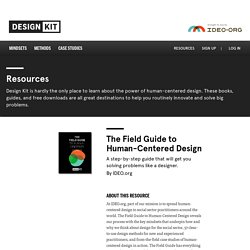
By IDEO.org About this Resource At IDEO.org, part of our mission is to spread human-centered design to social sector practitioners around the world. Unlocking the Potential of Digital Ethnography. By Anne Lacey, antedote The first time I drove across the United States, I couldn't help but be struck by how different each state and region feels.

Even so, I saw that there were clear commonalities that tie together to make the U.S. a single nation. The closest I've come to gaining a grasp of what makes that nation tick has come from examining both the commonalities and differences between all its people and place. It's been the project of a lifetime to develop anything resembling a coherent and comprehensive of picture of just this one country. Why You Only Need to Test with 5 Users. Method Cards. IDEO Method Cards is a collection of 51 cards representing diverse ways that design teams can understand the people they are designing for.
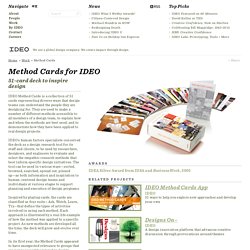
They are used to make a number of different methods accessible to all members of a design team, to explain how and when the methods are best used, and to demonstrate how they have been applied to real design projects. IDEO’s human factors specialists conceived the deck as a design research tool for its staff and clients, to be used by researchers, designers, and engineers to evaluate and select the empathic research methods that best inform specific design initiatives. The tool can be used in various ways—sorted, browsed, searched, spread out, pinned up—as both information and inspiration to human-centered design teams and individuals at various stages to support planning and execution of design programs.
Creative Confidence by Tom & David Kelley. “Design Thinking” in Harvard Business Review at IDEO.
How Do You Transform Good Research Into Great Innovations? This is the first essay in a three-part series by Jon Kolko, author of the new book Exposing the Magic of Design, on how to embrace design synthesis in your organization.
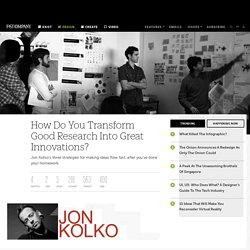
You've just completed design research in the field, capturing hours of video, thousands of photos, artifacts, papers, and documents. And now, you're stumped and overwhelmed.
Interviewing. Amazon.com: Interviewing Users: How to Uncover Compelling Insights eBook: Steve Portigal: Kindle Store. Extremes. Observe. PEAK-END RULE: ONE WAY TO IMPROVE THE CUSTOMER EXPERIENCE. The peak-end rule is a psychological phenomenon discovered by Nobel Prize winner Daniel Kahneman (psychologist).
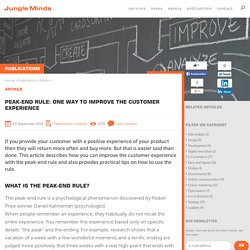
When people remember an experience, they habitually do not recall the entire experience. You remember this experience based only on specific details: “the peak” and the ending. What does Pair Design look like? If you’re trying to figure out whether Pair Design is right for you or your organization, it’s useful to have a model of what it looks like across an interaction design project.
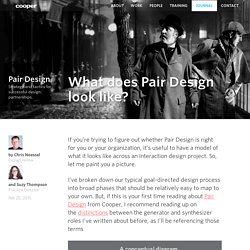
So, let me paint you a picture. I’ve broken down our typical goal-directed design process into broad phases that should be relatively easy to map to your own. But, if this is your first time reading about Pair Design from Cooper, I recommend reading up on the distinctions between the generator and synthesizer roles I’ve written about before, as I’ll be referencing those terms Research is your first chance to experience the power of pair design, but it’s also your first chance to fall victim to one of its classic blunders. Stakeholders will often try to split the team up during the research phase to double the number of interviewees. Persona Empathy Mapping. “No one cares how much you know, until they know how much you care”- Theodore Roosevelt Empathy -- it’s a buzzword in the UX design world.
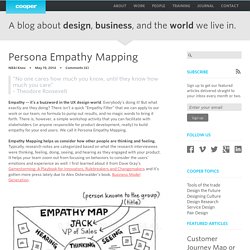
Everybody’s doing it! But what exactly are they doing? There isn’t a quick “Empathy Filter” that we can apply to our work or our team, no formula to pump out results, and no magic words to bring it forth. There is, however, a simple workshop activity that you can facilitate with stakeholders (or anyone responsible for product development, really) to build empathy for your end users. Empathy Mapping helps us consider how other people are thinking and feeling.
Moodboards. Moodboards (sometimes called inspiration boards) are collages made of images, textures, fabric and text used by designers to communicate moods, ideas and feelings visually.

Aa a picture is worth a thousand words, mood boards allows to convey complex ideas and large amounts of data quickly. Moodboards can be used to explore a concept, a product vision, a design style, a color palette, a phoyography style, the look & feel of a project or any other element of the project that is difficult to communicate with words. Creating a Moodboard could be quite time consuming as each image should be selected carefully to convey the desired feel, but the value is incredibly high as it help aligning a team to a vision. Tool Moodboards can be created in a physical or digital form. References Case Study. Business Modeling Tools & Design Process. Scenarios for coupling Design Thinking with Systematic Engineering Design in NPD.
1ST CAMBRIDGE ACADEMIC DESIGN MANAGEMENT CONFERENCE, 7 – 8 SEPTEMBER 2011Page of 14.
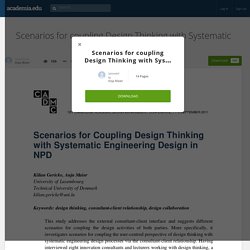
WEDO. Pensee-design-design-thinking-veeb-design.pdf. Le marketing sensoriel des services et des expériences client. Innovation et Design Thinking : 3 secrets pour générer des idées incroyables. Value Proposition Design Companion. Le Design Thinking : de la « boîte noire » du designer à la boîte à outils de l’innovateur – PART 2 – idcampus.be. Please Don't Stereotype Your Personas by @TheGrok. Design Driven Innovation - Collection. Amazon. Innovation By Design: Part 2. Radically Innovating What Things Mean One of the most thought provoking theories of innovation proposes to reshape competition by innovating the meaning of products and services. Roberto Verganti, Professor of Management of Innovation at Politecnico di Milano, discusses this theory in his book Design Driven Innovation: Changing the Rules of Competition by Radically Innovating What Things Mean. Design driven innovation uses design thinking to define problems and then to derive valid solutions to them.
Valid solutions are those that appear promising; they fit the evidence but can not be proven correct before being tried. We don’t often think about the meaning of products and services; their meaning seems innate, inseparable from the thing itself. These changes in meaning were not accidental. Meaning can be considered as another dimension of innovation. Significant advantages can accrue to companies that innovate meaning. Steve Jobs introducing the iPad, Jan. 27, 2010. Insights for Innovation. Véronique Hillen : Le « design thinking » s'intéresse à l'expérience des utilisateurs, Sciences & Prospectives. De toutes les méthodes permettant d'innover, le « design thinking » semble avoir le vent en poupe. Pouvez-vous nous en expliquer les principes ? Cette méthode, née dans la Silicon Valley, est très liée à cet état d'esprit tourné vers l'entrepreneuriat.
Les étapes du Design Thinking. Dès que l’on parle de créativité, il ne faut pas s’attendre à trouver un process précis et scientifiquement validé qui permette à chaque fois de trouver l’idée géniale à laquelle personne n’avait pensé. Pourtant, il existe un processus de réflexion/action suffisamment précis pour indiquer des points de passage obligés tout en restant suffisamment large pour s’adapter à divers champs d’applications. Passer de l’idée au produit, de la stratégie à la création de marque, du marketing au modèle économique, de la prospective à l’usage etc. Singularité – The Creativists. #3 Devenir un serial innovator ? Comme expliqué dans le billet 1 de cette série d »inspiraCtions « Voir ce que les autres ne voient pas », vous revenez certainement de vacances avec de nouvelles idées inspirantes, qui peuvent faire la différence et avez envie de les mettre en œuvre.
Soyons honnêtes, le chemin peut être difficile pour développer une #innovation de rupture et la lancer avec succès sur le marché dans une entreprise établie – et encore plus difficile de le faire plus d’une fois. C’est ce que nous avait rappelé les trois chercheurs Griffin, Prix et Vojak dans leur livre « Innovateurs en série : Comment les individus créent et proposent des innovations révolutionnaires dans les entreprises matures » (Stanford, Californie: Stanford University Press, mai 2012). Cette rareté se justifie par la spécificité des caractéristiques de ces innovateurs en série ; ils possèdent une combinaison inhabituelle de compétences.
Personas: The Magic behind the Mirror by @TheGrok. Commerce crosscanal pratiques et performances. Référentiel Client Unique. Référentiel Client Unique. PCH Innovations. Réussir ses parcours et son expérience client. Intervention Tribune de l'innovation : Best practices Parcours clients. Neck Down Designing: using service design & bodystorming to move from… Welcome to Forbes.